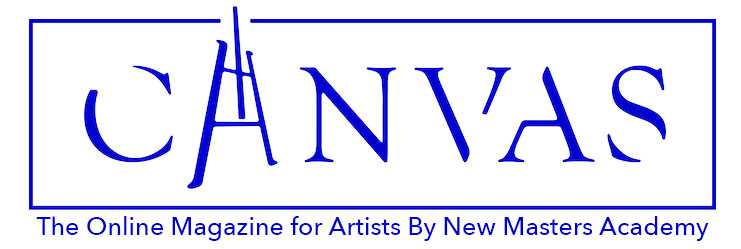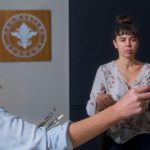New Masters Academy has added the first complete sight-size drawing course to the video library. The course, a total of 47 hours, is hosted by the director and founder of the Florence Academy of Art Daniel Graves, taught by the FAA’s former director of the sculptor’s drawing program, Leo Mancini-Hresko, and former principal instructor Joe Altwer.
Canvas asked Amy Florence, a professional painter and former instructor at the Charles H. Cecil Studios about her journey as a classical realist painter and her insight into drawing and painting using the technique sight-size.
| Click here to learn more about the Course. |
Frustrated with the lack of technical training offered in London, I traveled to Florence at the age of 17. I’d seen a portrait painting in a magazine that looked so alive and was amazed to find out that a 22-year-old British girl painted it. Having grown up in central London, which at the time was at the forefront of conceptual art, I didn’t know that people were still interested in representational painting. I’d see masterpieces in The National Gallery and Tate Britain, but the art schools were filled with students wanting to be the next Tracey Emin or Damien Hirst.
As a classically trained pianist, I valued the importance of learning your scales before composing your music.
My determination led me to a small atelier in a deconsecrated church in the San Fredianno district of Florence. It was filled with students drawing and painting from life, there to hone their technical skills using something they called the sight-size technique. I trained and subsequently taught there for the next five years.
The term sight-size refers to a complete procedural approach to drawing and painting taught by academies and ateliers around the world, such as the Florence Academy of Art and the Charles H. Cecil Studios were I studied and taught. Sight-size is an arrangement of the artist, subject and artwork that allows the artist to see their subject and artwork one-to-one.

As a measuring technique, sight-size is effective at training the eye to see, whereby the sum of the parts contributes to the whole. It is primarily a portrait technique; however, it may be used for still-life and landscape painting.
Sight-size requires the model to sit alongside the canvas, enabling the artist to view both side-by-side at a distance, and to the scale of life. The aim is to transfer the visual image of the model on to the canvas, working one-to-one. The artist makes all their observations at a given distance, before making a mark on the canvas and retreating to the viewing position.
When I began my training, we were introduced to the technique through cast drawing in charcoal — working for two weeks on the same drawing until we had pushed our eyes to a new level of accuracy. Initially, I found the technique almost mathematic, using plumb lines to transfer measurements from cast to paper and meticulously mapping out the edges of things. When you are forced to confront the mistakes in your drawing, you quickly begin to learn how to see as well as become more disciplined. Once I’d completed a number of casts, I progressed onto portrait drawing and subsequently to portrait painting, always working with the sight-size technique.

Through the process, the eye becomes more sensitive to detail, more efficient and accurate in line, value, and color. You learn to think in a visual way, understanding what you are actually seeing from that distance rather than what you imagine to see. Up close sight-size paintings tend to be more impressionist; eyes simplified to dark circles that melt into the whites of the eyes, mouths that are a few dashed brush strokes, that at a distance appear to be alive.
A fundamental part of the sight-size technique is to work from life. Observing the subject over time is a wonderful catalyst to creativity, opening up a potential for variety and spontaneity that cannot exist for those working from photographs.
The impressionist aspect of sight-size is what I find the most appealing. The visual trickery of a painting that appears to be so present and real, but up-close breaks up into painterly brushstrokes. There is no unnecessary detail; what you cannot see from a distance is not needed.
Stepping back from your model and your canvas to observe both from a distance goes back to Leonardo Da Vinci. He states the importance of distance to the model to see harmony and proportion. The Florentine artists were known for painting from initial studies and drawings; the Venetians, however, painted from life. Titian’s late portrait of Pietro Aretino is one of the earliest portraits to convey a unity of impression when seen at a distance.
I was extremely fortunate to study this painting up close. My former studio was next door to art restorers, who invited me in to see what they were working on one morning. On an easel in the middle of the room was Pietro Aretino, unframed, and with the yellowed varnish cleaned off. From a distance, the highlights jump off the coat and draw your eye up to the portrait of a man who appears as if he is about to step forward and speak. I was astounded by how contemporary and alive the painting appeared.

Sir Joshua Reynolds studied in Rome and Venice before returning to London, where he developed a portrait style that combined poses taken from classical sculpture with allusions to 16th-century Venetian painting. Reynolds advised his students to:
“… paint at the greatest possible distance from your sitter, and to place your picture near the sitter … so as to see both together.”
Reynolds worked with the canvas beside the model throughout the painting process. There are accounts of Thomas Gainsborough, George Romney, Gilbert Stuart, Sir Henry Raeburn, and James Abbott McNeill Whistler all painting in this way.
Advocates of the sight-size tradition believe John Singer-Sargent used a form of the technique. Sitters describe Sargent’s process of painting which is identical to Raeburn’s.
“Every stage was a revelation. For one thing, he put his easel directly next to the sitter so that when he walked back from it he saw the canvas and the original in the same light, at the same distance, at the same angle of vision” – Julie Heyneman commenting on a painting demonstration given by Sargent.
The next time you are fortunate to be confronted with a painting by Sargent, begin by standing close to the canvas and walk back. As you do so the painting will begin to come into focus from a distance, and the brushstrokes begin to unify. To me, this suggests that he made most of his decisions for the painting, at this distance.

In the aftermath of the First World War, many artists turned to Modernism, and knowledge of traditional methods fell into decline. Sargent’s periodic visits to Boston sustained a link with European portrait practices. Dennis Miller Bunker and Frederick Porter, the founding members of the Boston school, both worked with and were painted by Sargent. Bunker taught William M. Paxton, who passed his knowledge on to R. H Gammel, who taught Charles H. Cecil, and Daniel Graves. Both went on and founded the most influential sight-size academies in the world today, located in Florence, Italy.
You will find countless literature on painting materials from the past, but few on the visual methods. The sight-size technique helped revive classical academic realism, thanks to a collection of small ateliers.
Sight-size is initially an effective and efficient method to train the eye to see. As the eye becomes more accurate, the hand follows, and through repeated practice, you can learn how to see. The eye is not something that you can turn off, and for me, the most beneficial part of my training was the way it changed the way I saw the world around me. As I’d walk back to my apartment in Florence, shadows would be strikingly blue against the ochre buildings. The sky was no longer just blue, but a gradation of values and colors arching above me. Everywhere I looked, I’d see paintings. I felt that I had found a way in. I could really see, and once I could see, I could begin to work out how to paint it.
Last November I taught sight-size portrait painting for the New Masters Academy’s complete sight-size painting course which will be available online this year.



Comment
Amy I’m so glad I that I just read about you and your amazing journey. I’m about to begin mine and will be training with you now as I sign up for the course.
At 52 years old I’ve just found my love of art again…I’m so excited Ha ha!
See you in class xx